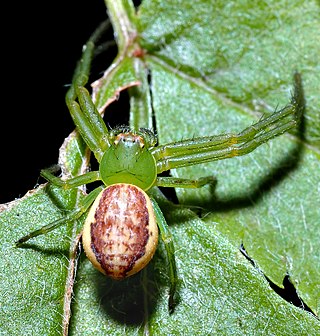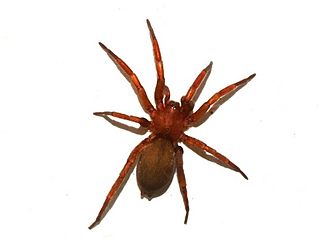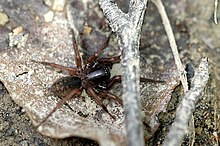
Tegenaria is a genus of fast-running funnel weavers that occupy much of the Northern Hemisphere except for Japan and Indonesia. It was first described by Pierre André Latreille in 1804, though many of its species have been moved elsewhere. The majority of these were moved to Eratigena, including the giant house spider and the hobo spider.

Xysticus is a genus of ground crab spiders described by C. L. Koch in 1835, belonging to the order Araneae, family Thomisidae. The genus name is derived from the Ancient Greek root xyst, meaning "scraped, scraper".

Diaea is a genus of crab spiders first described by Tamerlan Thorell in 1869. Most species are found in specific locations except for D. livens, which occurs in the United States and D. dorsata, which has a palearctic distribution. Adults are 5 millimetres (0.20 in) to 7 millimetres (0.28 in) and tend to hide in and around vegetation, especially flowers, where their color allows them to blend in to their surroundings.
Ozyptila is a genus of crab spiders that was first described by Eugène Louis Simon in 1864. It has been misspelled as "Oxyptila" in multiple accounts.

Amaurobius is a genus of tangled nest spiders that was first described by Carl Ludwig Koch in 1837.

Clubiona is a genus of sac spiders that was first described by Pierre André Latreille in 1804.

Pardosa is a large genus of wolf spiders, commonly known as the thin-legged wolf spiders. It was first described by C. L. Koch, in 1847, with more than 500 described species that are found in all regions of the world.

Pachygnatha is a genus of long-jawed orb-weavers that was first described by Carl Jakob Sundevall in 1823.

Zelotes is a genus of ground spiders that was first described by J. Gistel in 1848.

Histopona is a genus of funnel weavers first described as a sub-genus of Hadites by Tamerlan Thorell in 1870. It was elevated to genus by Brignoli in 1972.

Gnaphosa is a genus of ground spiders that was first described by Pierre André Latreille in 1804. They all have a serrated keel on the retromargin of each chelicera.

Agyneta is a genus of dwarf spiders that was first described by J. E. Hull in 1911.

Haplodrassus is a genus of ground spiders that was first described by R. V. Chamberlin in 1922. They range from 3 to 10 millimetres. H. signifer is the most widespread species, found across North America except for Alaska and northern Canada.
Psammitis is a genus of crab spiders first described by Anton Menge in 1876.












